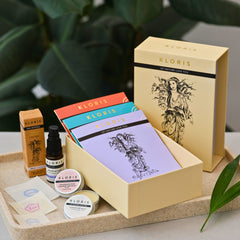Table of Contents
Table of Content

If you read our previous skincare article where we explored the benefits of adding a CBD face oil to your daily ablutions, you’ll already know a bit about why every part of the cannabis plant (especially the cannabinoids within and their interaction with our in-built endocannabinoid system) makes a welcome addition to skincare products. But of course, skincare doesn’t stop at our faces.
The skin is our largest organ, a protective barrier that covers the entire body, which relies on the optimum function of a vast number of cannabinoid receptors. You can consider our deliciously scented CBD body oil and our new Hand & Body Lotion as a much-needed, direct nutrient boost for the surface of your skin, the multiple layers below and our internal processes as a whole. Here’s why…
Anandamide – Bliss for the skin
Anandamide (AEA), affectionately known as ‘the bliss molecule’, has a name derived from the Sanskrit word for happiness, pleasure, joy, and delight. And with good reason. The discovery and isolation of this miraculous molecule back in 1992 sparked early research into cannabinoid receptors, which were found to be in great abundance throughout the human body.
Further research over the years has revealed that AEA is always present in the body, positively impacting pain, inflammation, appetite, anxiety, movement control and much, much more. However, many factors such as poor diet, lack of sleep, daily stress and more can hinder the amount of free-flowing ‘bliss’ and therefore, the benefits.
Bringing CBD into the picture does many incredible things, one of which being that it inhibits the enzyme (FAAH) which degrades AEA, allowing Anandamide to pass through the far-reaching endocannabinoid system restoring balance and wellbeing in a multitude of ways.
So, what does this mean for the skin?
This bliss molecule is becoming well-known for how it improves mental wellbeing, but the CB1 and CB2 receptors which bind and interact with AEA (and at least six other neurotransmitters) are found in almost every skin cell. The ones most closely studied so far are AEA and 2-AG (endogenous agonist of the CB1 receptor, the primary endogenous ligand for the CB2 receptor). Their effects on the four main skin cell types (keratinocytes, mast cells, melanocytes, and sebocytes) are endlessly astonishing scientists working in the dermatology field.
Keratinocytes & Mast Cells
A keratinocyte is an epidermal cell which produces keratin, a key structural material for making up hair, skin and nails. As you might imagine, it is one of the most important cells of the skin.
There is growing evidence to suggest that AEA, which is wonderfully and uniquely supported by the presence of cannabinoids such as CBD, helps to control skin differentiation (the process in which cells mature and become more distinct in form and function.)
Furthermore, AEA activates the CB1 and CB2 receptors found in skin cells which control both inflammation responses and pain transmission, making this a skincare must-have for those with uncomfortable, sensitive or irritated skin conditions such as acne, eczema or dermatitis.
Mast cells are a tissue cell of the immune system, found on the surface of the skin and throughout the body. They play a vital role in mediating inflammatory responses and allergic reactions as well as being involved in wound healing and blood vessel formation. They also contain both CB1 and CB2 receptors.
Overactive mast cell activation is often found in people with skin conditions, which can present as inflammation. The release of AEA, allowed by the cannabinoid interaction with CB1 and CB2 receptors, helps to regulate mast cell response and produce fewer pro-inflammatory molecules when an over-reaction is occurring.
Melanocytes & Sebocytes
You may guess from the name that melanocytes are the cells which protect the skin from harmful UV radiation. They are also the cells which, when damaged, can get out of control and become cancerous melanoma cells. When activated by CBD products, the release of AEA and the effect on cannabinoid receptors CB1 and CB2 has been shown to help mediate damage caused by harmful rays and other free radicals.
Last but not least, the skin cell we looked at in our blog explaining why our CBD face oil is your new best friend: sebocytes.
These cells control the production and release of sebum on the skin – the natural oil our skin needs to form an effective, water tight, protective layer to pollutants in the outside world. When these cells fail to work correctly, potentially due to an endocannabinoid deficiency, sebum can be produced in excess (resulting in oily skin and acne) or not produced enough (resulting in sore, dry skin conditions). Several cannabinoids have been shown to regulate these cells and sebum production, through interaction with the CB1 and CB2 receptors.
As with all aspects of the cannabis plant, the endocannabinoid system and receptors, we are learning more every day. And the more we discover, the more amazing this plant seems to be. For now, we know that our endocannabinoid system plays a huge role in maintaining well balanced, healthy skin and that cannabinoids (such as CBD) offers support to that process like nothing else. So, treat yourself! Treat your skin.





